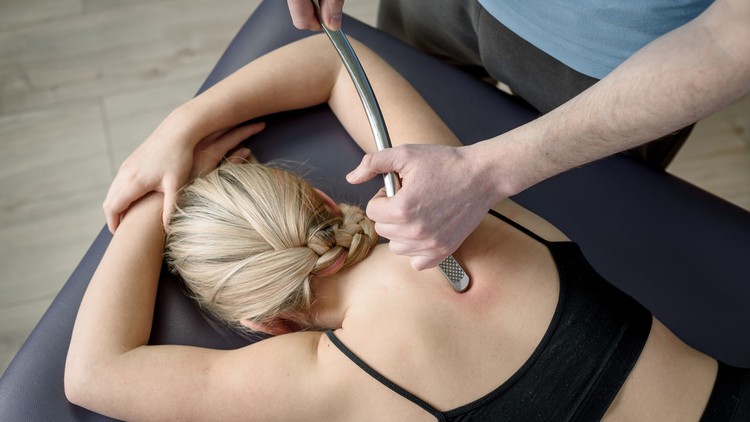
Level 1 IASTM technique diploma course
What you will learn
1. IASTM Introduction
2. IASTM fundamentals
3. Use of IASTM tools
4. Description of IASTM tools
5. Treaments & history
6. IASTM foundation techniques
7. What is IASTM
8. IASTM foundation techniques
9. IASTM for scar tissue breakup
10. IASTM treatment protocols
11. Conditions to use IASTM
12. Detect soft-tissue adhesions
13. IASTM for calfs & hamstrings
14. IASTM techniques on cervical
15. IASTM for lower & upper back
16. IASTM techniques on foot and ankle
17. IASTM for legs & quads
18. IASTM techniques on edema and scars
19. IASTM for arms & pectoral
20. IASTM techniques on hand & forearm
21. IASTM for neck & trapezius
22. IASTM technique on Knee & thigh
23. Congrats for level 1 IASTM
Description
What Is IASTM?
Though doctors of chiropractic (DCs) have always used their hands to increase blood flow and break up restrictions ininjuredsofttissue, fingersalonecan’t
detect restrictions at deeper levels or treat the full range of restrictions. Because of this, several companies have now developed handheld tools to perform-instrument-assisted-soft-tissuemobilization.
Graston is the leading technique when it comes to IASTM, says Dr. Heller. It has developed a set of six stainless steel instruments of various shapes and sizes. “You would want an instrument with a beveled edge to go deeper into the tissue, and you would use an instrument with a flat edge if you were working more on the surface,” explains Dr. McCathie. Though many different materials have been used to make the instruments—wood, ceramics, plastics, stone— stainless steel appears to be the best, says soft-tissue expert Warren Hammer, DC, DABCO, who practices in Norwalk, Conn. “Stainless steel instruments have. the highest resonation and make it easier to feel both local and broad areas of tissue restriction,” he con- tinues. “Using the tools produces outcomes that are equal to, or better than, palpation by hands.”
IASTM has two main functions: to break up abnormal densities in tissue, such as scar tissue, and to reinitiate first-stage healing in the body. “When a body is injured, it sends blood, specifically the healing substances found in white blood cells, to the wounded area to begin laying down new collagen tissues and repairing the injury—building scar tissue,” says Dr. Heller. “IASTM is like a mild injury to the tissue which starts this process over again and helps the body to heal itself,” he adds. Though scar tissue is essentially a “patch” at the site of an injury, helping it to heal, it is much less flexible than normal tissue. In the long run, scar tissue can cause restricted motion, which leads to pain when, for example, a patient with a sprained ankle tries to return to running. Typically, patients with soft-tissue injuries do not seek out a DC until the injuries have become chronic, usually months post-injury. By this point, the body has completed most of its self-healing process—scar tissue has built up, restricting motion—and it’s necessary for the DC to restart the curative process.
It’s important to note that what gives IASTM the ability to reinitiate first-stage healing is that it is essentially reinjuring the body, although to a lesser degree, which may cause discomfort during the procedure and bruising afterward. “Patients may experience soreness in the treatment area for a day or two following IASTM,” explains Dr. Heller.
Dr. Hammer explains that most of the tissue treated by DCs is not actually scar tissue but is densification of the loose connective tissue beneath the deep fascia due to entanglement of hyaluronic acid (HA) molecules, causing a gel-like restriction. It has been found that increased temperature and friction normalize the HA, allowing freedom of the gliding betweenthefasciallayers toreturn. According to Dr. Hammer, the injuries—or types of injuries—that respond best to IASTM include acute and chronic spinal and extremity problems, such as tendinopathies, Achilles tendinosis, rotator cuff injuries, IT band syndrome and plantar fasciitis, among others. And Dr. Heller notes that the patients who see the best results from IASTM are those who are younger and more physically active. “A person who is willing to exercise the involved tissues is more likely to respond well to this particular type of treatment,” he says. “But that doesn’t mean that it won’t work on older patients or on those withamoresedentarylifestyle.”